Investigation of Foam Mobility Control Mechanisms in Parallel Fractures
Abstract
1. Introduction
2. Materials and Methods
2.1. Instruments and Materials
2.2. Experimental Methods
2.2.1. Foam Stability and Decay Mechanism
2.2.2. Mobility Control Experiments of the Foam in a Parallel Fracture Model
3. Results
3.1. Foam Stability and Decay Mechanisms
3.1.1. Influence of the Temperature and Salinity
3.1.2. Decay Mechanism of the Foam System
3.2. Mechanism of Enhanced Oil Recovery by Foam Control Mobility
3.2.1. Foam Release Shielding Effect
3.2.2. Mobility Control with Foam Under Different Fracture Opening Ratios
3.2.3. Adjustment of the Foam Injection on the Diversion Rate
4. Conclusions
- (1)
- Gel foam sustains a substantial liquid film thickness for up to 120 min. This durability is attributable to the three-dimensional network structure established post-gelation, which confers superior foam stability compared to the other two foam systems evaluated.
- (2)
- As salinity increases, the viscosity of the base liquid in conventional foam exhibits minimal variation. In contrast, the viscosity of the polymer foam base liquid undergoes a substantial decline at high salinity, dropping below 100 mPa·s, while the viscosity of the gel foam base liquid initially increases before subsequently decreasing. Furthermore, at elevated temperatures, the base liquid viscosity of all three foam systems demonstrates a pronounced reduction.
- (3)
- Greater foam stability corresponds to enhanced mobility control capability. At a fracture opening ratio of 10, conventional foam fails to initiate flow in small fractures. In contrast, polymer-enhanced foam, with an injection volume of 25.8 pore volumes, achieves a maximum diversion rate in small-opening fractures of less than 10%. Gel foam, however, with an injection of 24 PV, attains a maximum diversion rate of 12.8% in small-opening fractures.
- (4)
- Foam between 0.2 mm and 0.6 mm fractures is more susceptible to disruption by resistance forces. This vulnerability results in an increase in foam particle size within these fractures, consequently diminishing its plugging efficacy. In contrast, gel foam exhibits superior mobility control characteristics, characterized by a more uniform and stable foam particle size distribution.
Author Contributions
Funding
Data Availability Statement
Acknowledgments
Conflicts of Interest
References
- Song, Z.J.; Yang, L.; Hou, J.R.; Wang, Y. Study on the characteristics of oil-water two-phase flow in fractures of fractured vuggy reservoirs. J. Xi’an Pet. Univ. (Nat. Sci. Ed.) 2018, 33, 49–54. [Google Scholar]
- Chen, Z.H.; Liu, C.H.; Yang, J.; Huang, G.; Lu, X. Development strategies for fractured vuggy carbonate oil and gas reservoirs: A case study of the Ordovician reservoir in the main development area of Tahe Oilfield. Petrol. Geol. Oilfield Dev. 2005, 26, 623–629. [Google Scholar]
- Han, G.H.; Qi, L.X.; Li, Z.J.; Fan, Z.J. Prediction technology for Ordovician carbonate fractured vuggy in Tahe Oilfield. Petrol. Geol. Oilfield Dev. 2006, 27, 860–870+878. [Google Scholar]
- Tang, H.; Xie, L.; Su, B.; Han, T. Fracture and cavity characteristics of Ordovician carbonate reservoirs in Tazhong area. J. China Univ. Pet. (Nat. Sci. Ed.) 2013, 37, 7–13. [Google Scholar]
- Guo, P.; Li, S.L.; Du, Z.M.; Yang, X.-F.; Liu, J.-Y. Evaluation of gas injection for enhanced oil recovery in low-permeability reservoirs. J. Southwest Pet. Inst. 2002, 24, 46–50+2. [Google Scholar]
- Guo, W.K.; Liao, G.Z.; Han, P.H. Techniques for Enhanced Oil Recovery by Gas Injection; Petroleum Industry Press: Beijing, China, 2003. [Google Scholar]
- Li, Y.H.; Li, J.L. Fractures and classified hierarchical modeling of carbonate fractured vuggy reservoirs. Pet. Explor. Dev. 2016, 43, 655–662. [Google Scholar] [CrossRef]
- Yang, Z.H.; Luo, Z.Y.; Lin, M.Q.; Lv, Q.C.; Li, X.C. Construction of a temperature-resistant foam gel system to improve CO2 flooding efficiency in low-permeability reservoirs. Oilfield Chem. 2020, 37, 86–92. [Google Scholar]
- Li, Z.M.; Li, B.F.; Xu, Y.H.; Lin, R.Y.; Shang, Z.H. Study on foam diversion characteristics and its application. J. Xi’an Pet. Univ. (Nat. Sci. Ed.) 2007, 116–118. [Google Scholar]
- Meng, F.L. Study on Water Production Patterns and Water Shutoff Strategies in Carbonate Reservoirs. Ph.D. Thesis, China University of Petroleum (Beijing), Beijing, China, 2019. [Google Scholar]
- Lu, X.G.; He, X.; Cao, B.; Wang, X.; Gao, J.; Liu, Y.; Cao, W. Mechanism, countermeasures, and practical effects of mobility inversion in polymer flooding. Acta Pet. Sin. 2023, 44, 962–974. [Google Scholar]
- Chen, J.; Liu, T.J.; Wu, H.R.; Hou, G.G.; Li, Z.; Kang, W.L. Screening and performance evaluation of gel/foam combined flooding system for high-permeability reservoirs. In Proceedings of the 16th Colloid and Interface Chemistry Conference of the Chinese Chemical Society—Session 6: Applied Colloid and Interface Chemistry, Qingdao, China, 25–28 July 2017; pp. 117–118. [Google Scholar]
- Li, Y. Development theory and methods for carbonate fractured vuggy in Tahe Oilfield. Pet. Rep. 2013, 34, 115–121. [Google Scholar]
- Wassmuth, F.R.; Hodgins, L.A.; Schramm, L.L.; Kutay, S.M. Screening and coreflood testing of gel foams to control excessive gas production in oil wells. In SPE Improved Oil Recovery Conference; SPE: Calgary, AB, Canada, 2000. [Google Scholar]
- Dai, Q.; Zhao, W.S.; Fan, C.S.; Liu, J.M.; Zhu, L.L.; Wu, X.Y. Rheological properties of foam gel mobility control system. Oil Gas Field Surf. Eng. 2010, 29, 15–16. [Google Scholar]
- Feng, X. Optimization and Interface Property Study of Gel Foam Water Shutoff System for Thin-Layer Bottom-Water Reservoirs. Ph.D. Thesis, China University of Petroleum (East China), Qingdao, China, 2014. [Google Scholar]
- Li, S.; Li, Z.; Li, B. Experimental study on foamed gel flow in porous media. J. Porous Media 2015, 18, 519–536. [Google Scholar] [CrossRef]
- Jin, J.F.; Wang, Y.; Wei, M.; Ma, H.; Wang, K. Coreflooding and pore-scale visualization of foamed gel flowed in porous network media. J. Dispers. Sci. Technol. 2016, 37, 1436–1443. [Google Scholar] [CrossRef]
- Lai, N.; Zhao, J.; Wang, J.; Gao, L.; He, Q. Influence of external conditions on the stability of inorganic gel foam and exploration of the mechanism of action. J. Mol. Liq. 2023, 369, 120873. [Google Scholar] [CrossRef]
- Du, R.F.; Zhang, Y.B.; Ge, S.; Li, W.; Dong, H.; Shan, Y.; Bian, Y. Optimization and laboratory evaluation of gel foam system for Weizhou high-permeability reservoir. Contemp. Chem. Ind. 2024, 53, 1519–1524. [Google Scholar]
- Moumni, Y.; Msaddek, M.H.; Chermiti, A.; Chenini, I.; Mercier, E.; Dlala, M. Quantitative analysis of fractured carbonate reservoir and hydrodynamic implications: Case study of Horchane-Braga basin (central Tunisia). J. Afr. Earth Sci. 2016, 124, 311–322. [Google Scholar] [CrossRef]
- Chen, L.M.; Kang, Y.S.; Zhu, J.C. Processing and information extraction of oil migration experimental images in fracture media. J. Pet. Univ. (Nat. Sci. Ed.) 2000, 115–116+122–133. [Google Scholar]
- Kang, Y.S.; Guo, Q.J.; Zhu, J.C.; Chen, L.M.; Zeng, L.B. Experimental study on oil migration simulation in fracture media. Acta Pet. Sin. 2003, 24, 44–47. [Google Scholar]
- Liu, Z.C.; Li, J.L.; Lü, C.Y.; Tan, Z.L.; Luo, M. Experimental study on the influence of storage space types on water cut in fractured vuggy reservoirs. Acta Pet. Sin. 2009, 30, 271–274. [Google Scholar]
- Long, Q.L. Study on Water Shutoff Mechanism in Fractured Vuggy Carbonate Reservoirs of Tahe Oilfield. Ph.D. Thesis, China University of Geosciences (Beijing), Beijing, China, 2009. [Google Scholar]
- Li, A.F.; Zhang, D.; Yao, J. Physical simulation of water injection development in fractured vuggy reservoirs. J. China Univ. Pet. (Nat. Sci. Ed.) 2012, 36, 130–135. [Google Scholar]
- Liu, Z.C.; Wang, Y.; Hou, J.R. Feasibility study on foam-assisted gas flooding technology for enhancing oil recovery in fractured vuggy reservoirs. J. China Univ. Pet. (Nat. Sci. Ed.) 2018, 42, 113–118. [Google Scholar]



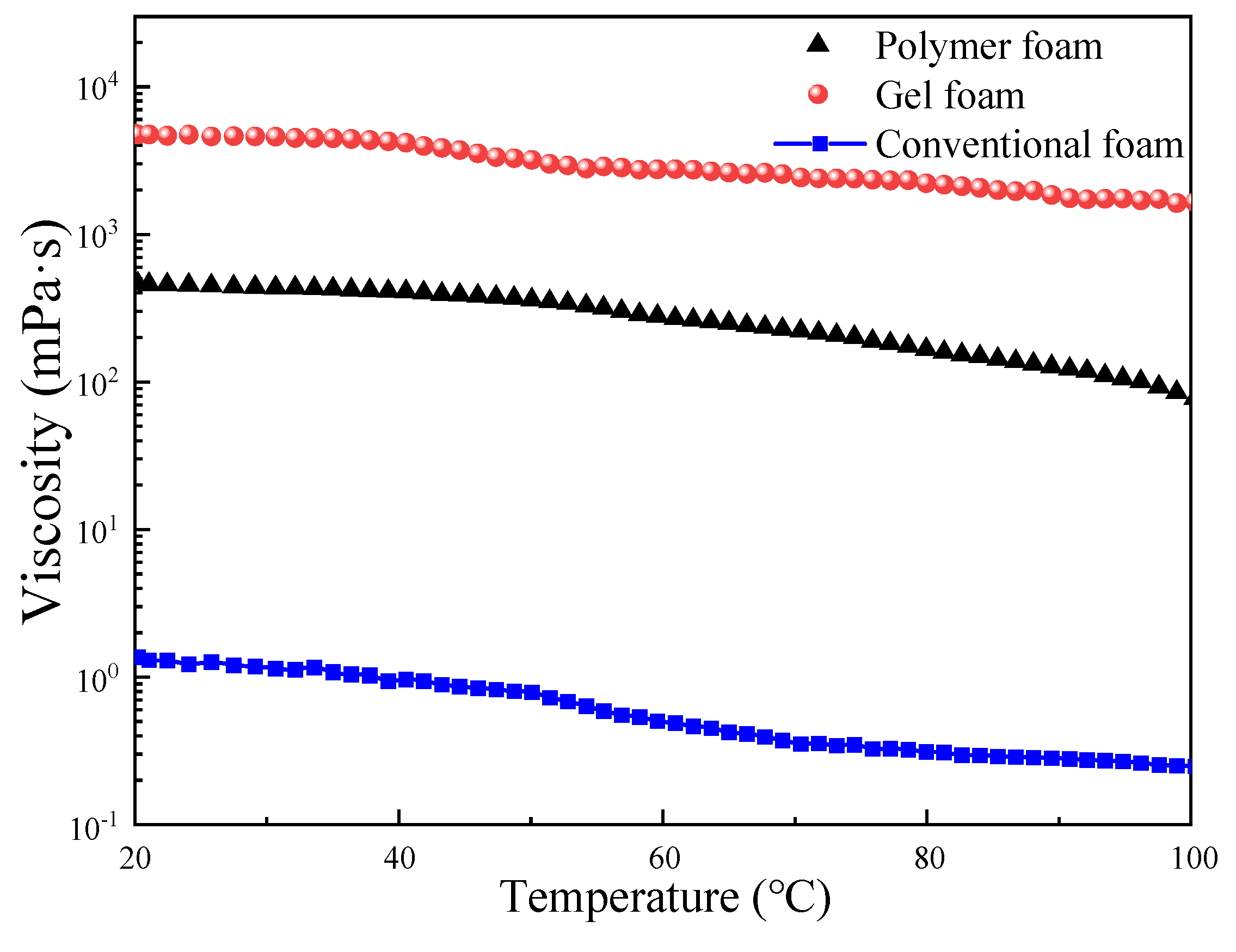


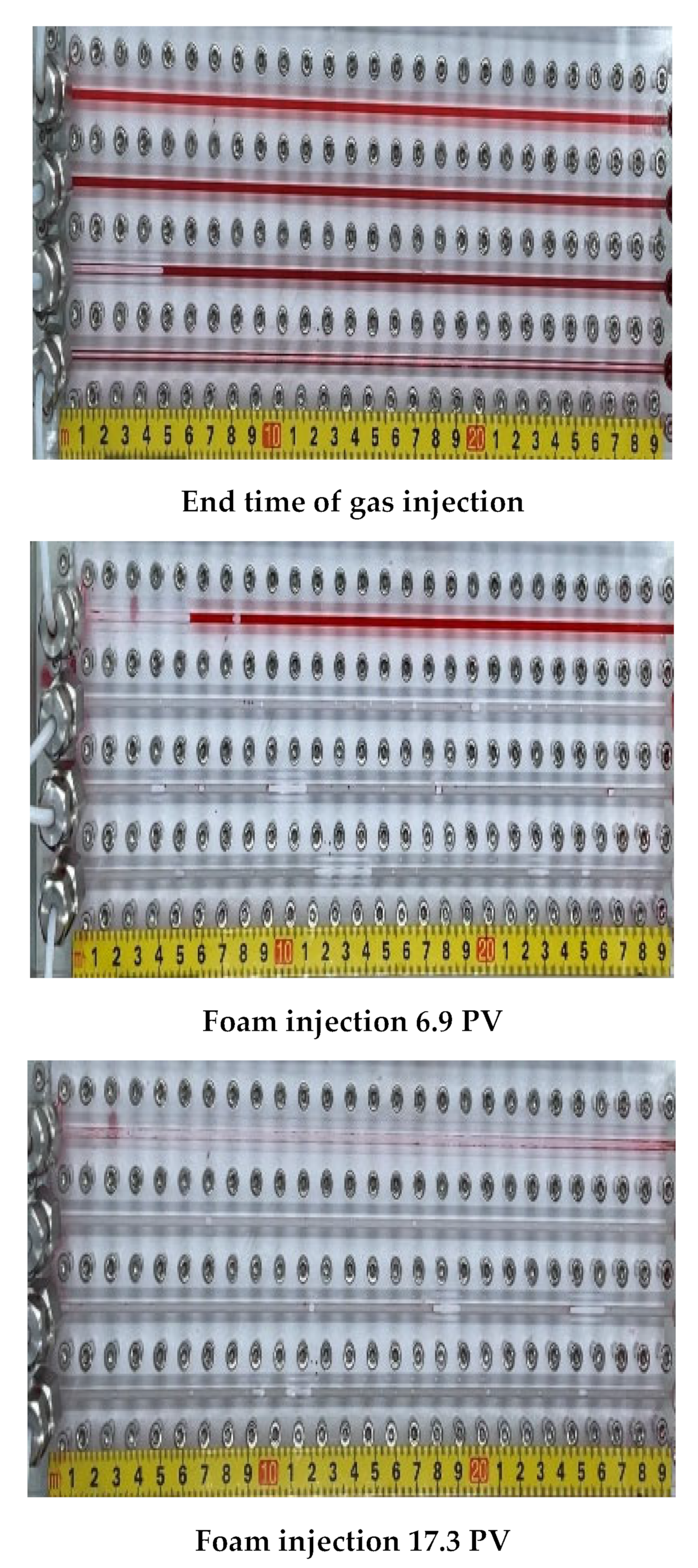
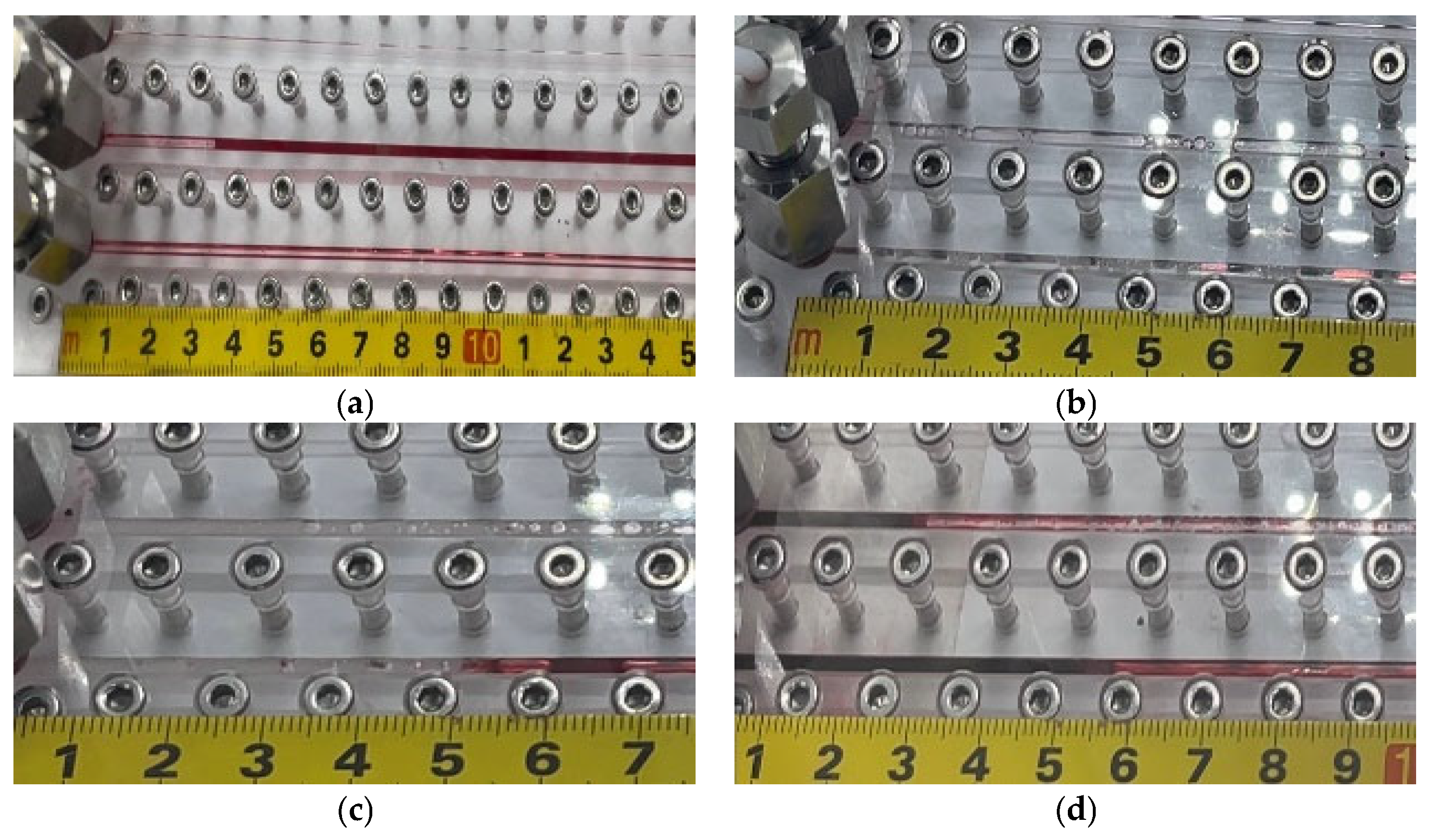
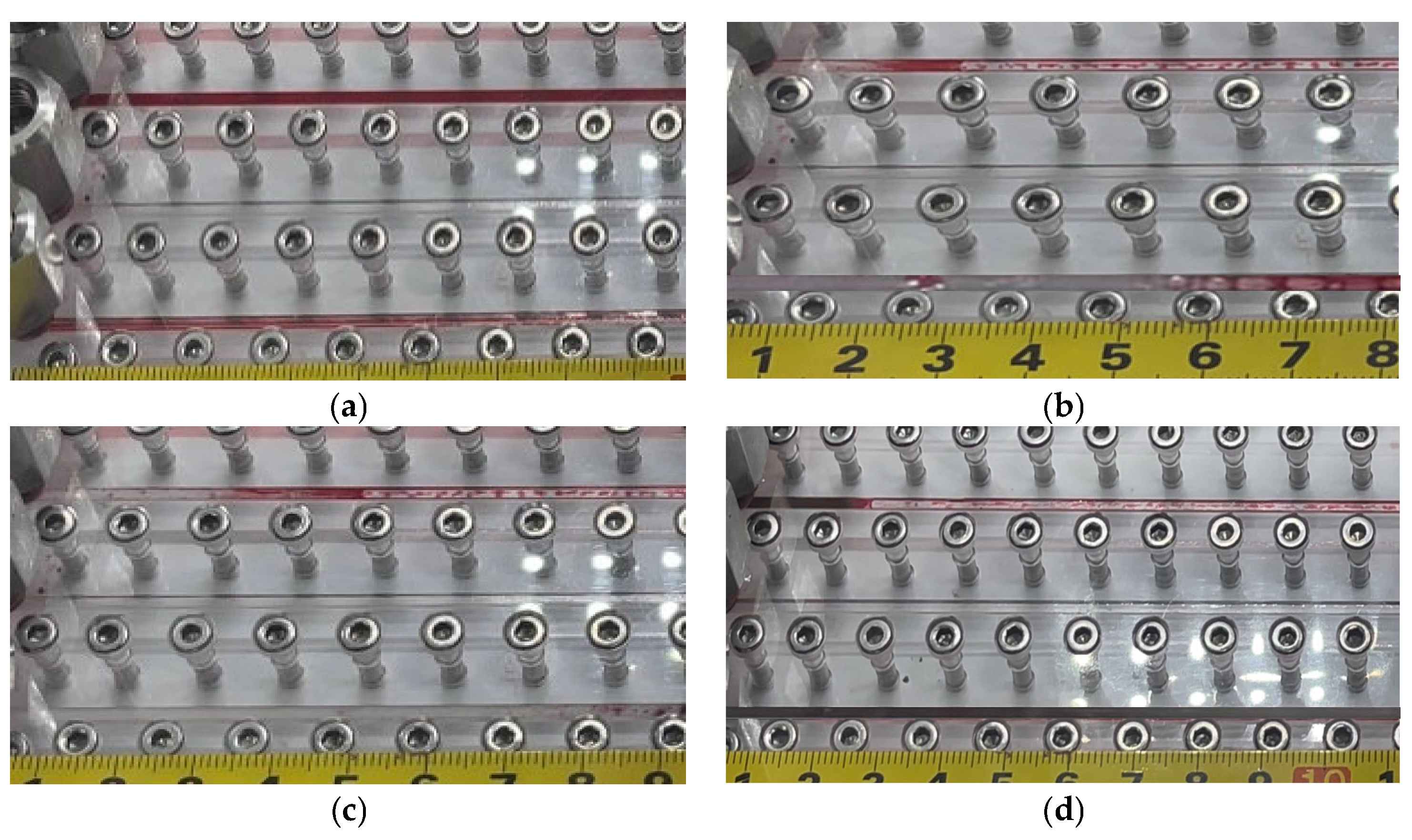

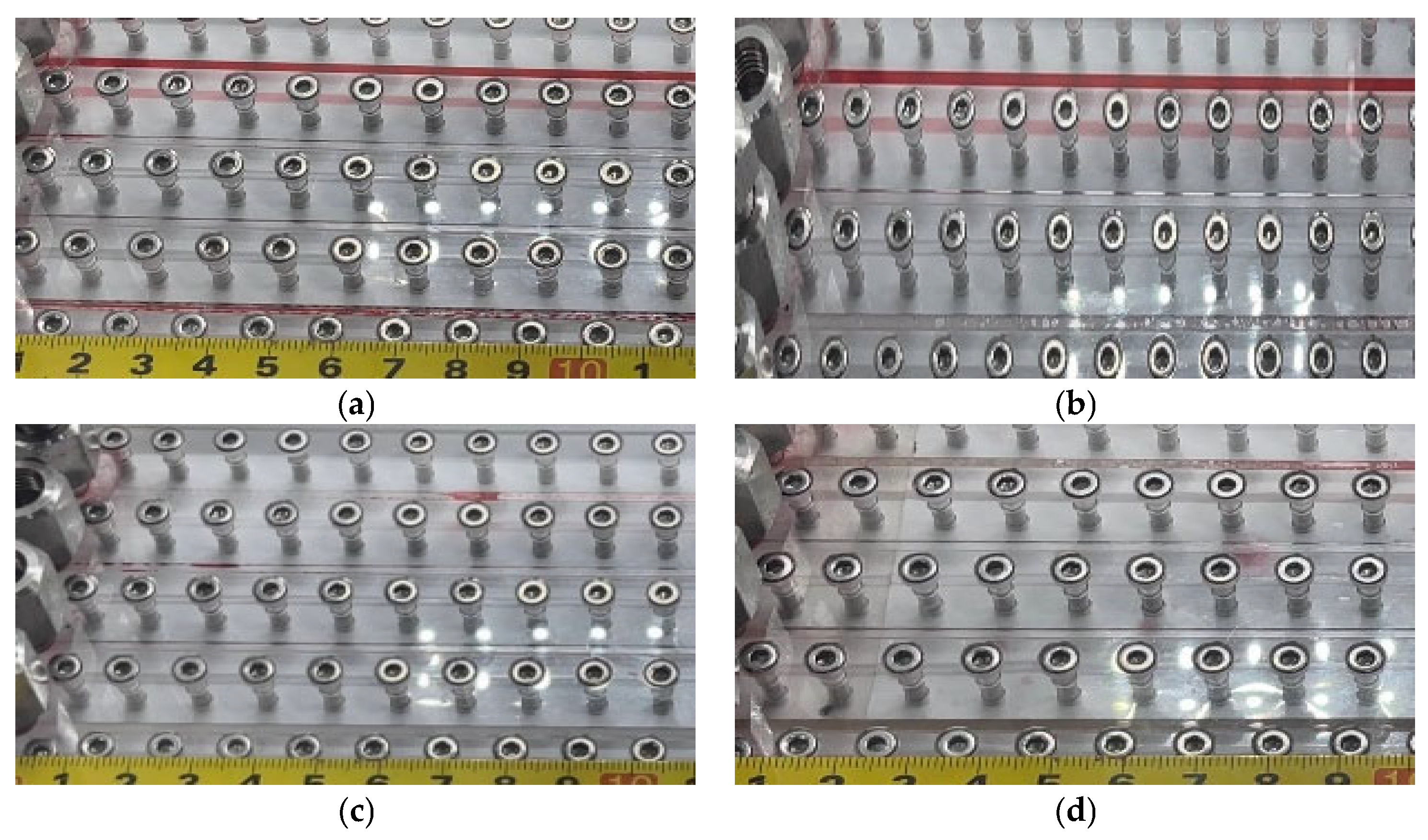
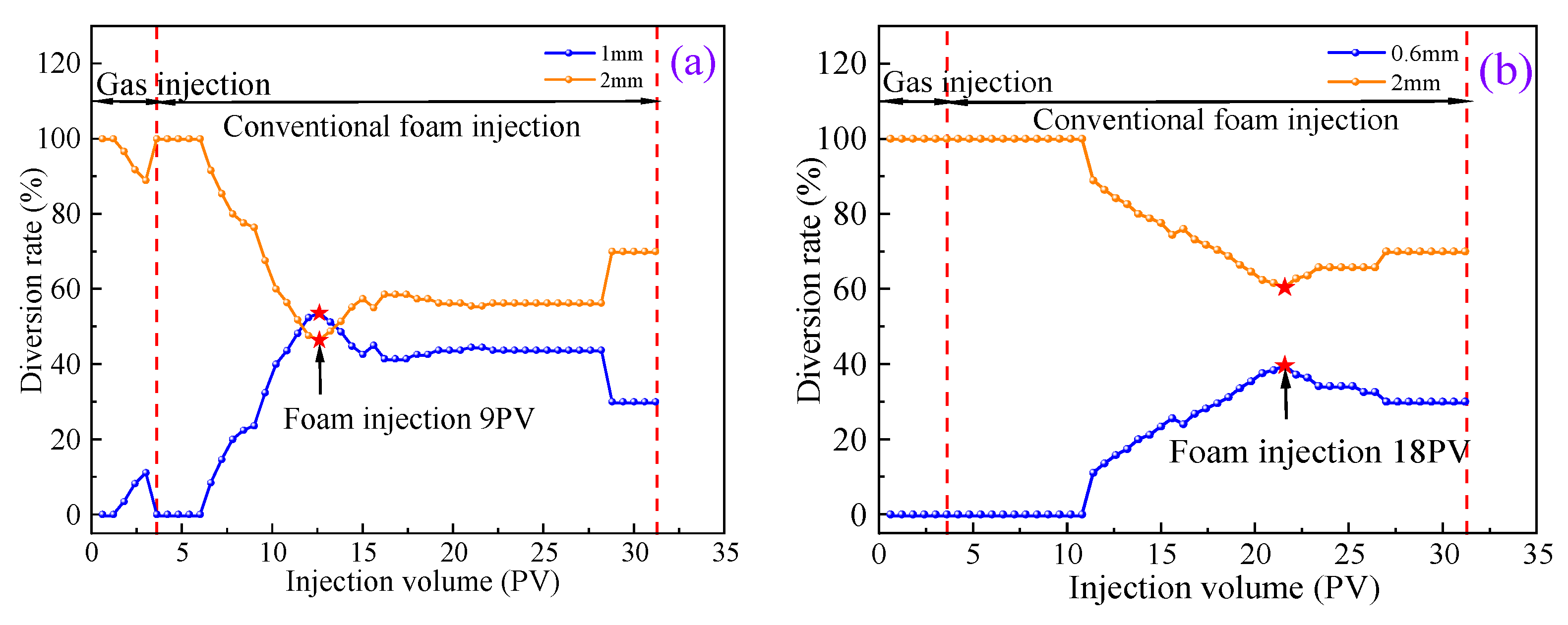


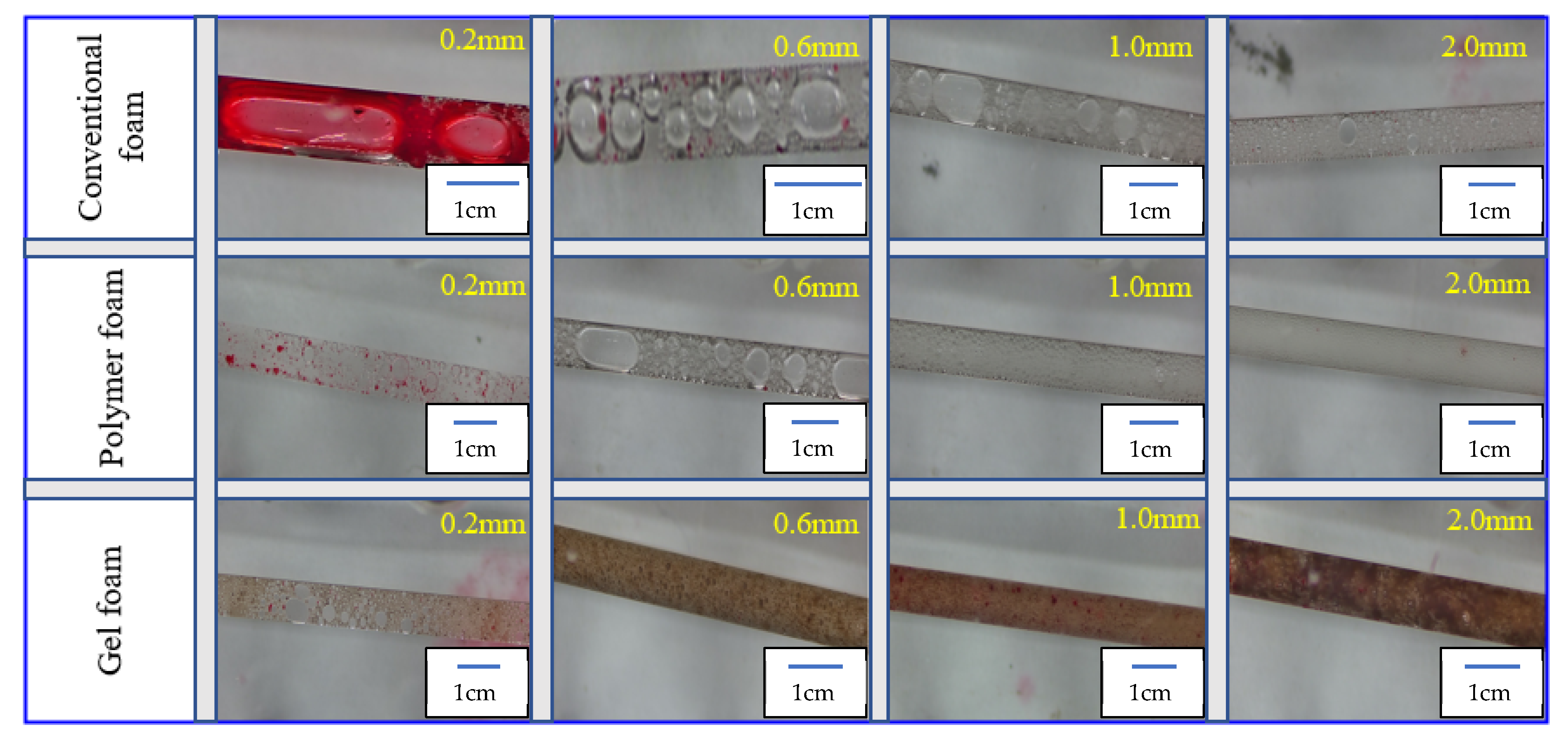
| Foam System | Foam Volume/mL | Half-Life/s |
|---|---|---|
| Conventional foam | 435 | 476 |
| Polymer foam | 280 | 6156 |
| Gel foam (after gelation) | 165 | >604,800 |
Disclaimer/Publisher’s Note: The statements, opinions and data contained in all publications are solely those of the individual author(s) and contributor(s) and not of MDPI and/or the editor(s). MDPI and/or the editor(s) disclaim responsibility for any injury to people or property resulting from any ideas, methods, instructions or products referred to in the content. |
© 2025 by the authors. Licensee MDPI, Basel, Switzerland. This article is an open access article distributed under the terms and conditions of the Creative Commons Attribution (CC BY) license (https://creativecommons.org/licenses/by/4.0/).
Share and Cite
Liu, X.; Feng, Y.; Wang, B.; Wang, J.; Xin, Y.; Li, B.; Xu, Z. Investigation of Foam Mobility Control Mechanisms in Parallel Fractures. Processes 2025, 13, 1527. https://doi.org/10.3390/pr13051527
Liu X, Feng Y, Wang B, Wang J, Xin Y, Li B, Xu Z. Investigation of Foam Mobility Control Mechanisms in Parallel Fractures. Processes. 2025; 13(5):1527. https://doi.org/10.3390/pr13051527
Chicago/Turabian StyleLiu, Xiongwei, Yibo Feng, Bo Wang, Jianhai Wang, Yan Xin, Binfei Li, and Zhengxiao Xu. 2025. "Investigation of Foam Mobility Control Mechanisms in Parallel Fractures" Processes 13, no. 5: 1527. https://doi.org/10.3390/pr13051527
APA StyleLiu, X., Feng, Y., Wang, B., Wang, J., Xin, Y., Li, B., & Xu, Z. (2025). Investigation of Foam Mobility Control Mechanisms in Parallel Fractures. Processes, 13(5), 1527. https://doi.org/10.3390/pr13051527







